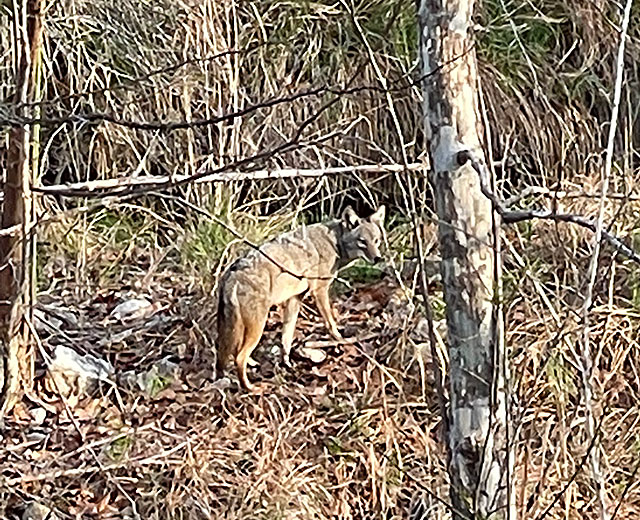A few months ago, I received a phone call from a neighbor who excitedly alerted me to a coyote that ran past his back yard and was heading my direction. Knowing how fast coyotes can run — like, really fast — I knew there was no chance that I’d spot it by the time I got off the phone, and I was right.
What I figured was a random, one-off spotting turned out to be the precursor to something more frequent, and for a number of people in the neighborhood, more worrisome. The coyote began to frequent the back part of the neighborhood, where a paved walking trail parallels the creek, and homes back up to the trail.
After a while, neighbors reported seeing it almost daily, usually in the late afternoon. Debbie and I spotted it several times, once accompanied by a second smaller coyote, presumably its mate.
It didn’t exhibit any behaviors that caused us to think it was rabid or otherwise sick, but it also wasn’t intimidated by human presence. It would quickly retreat twenty yard or so toward the creek when someone came down the trail, but as soon as they passed, it would return to its previous position, staring into the fenced back yards of the homes along the trail.
Eventually, people began to fear for their animals, their small children and grandchildren, and even for their own safety. It’s one thing to read that coyote attacks on humans are exceedingly rare; it’s another to have that “lean and hungry look” pointed in your direction as the sun begins to set.
Our POA reached out to the city’s Animal Control department to see what could be done, and we were initially told that there was nothing they could do. The game warden was then called in and he reportedly was confronted by a neighbor who was apparently a coyote fan, and told to leave and not come back. (I’ve been unable to verify the truth of that story, by the way.)
At that point, a few homeowners began to tell us that if something wasn’t done, they’d take things into their own hands. Given the potential for disaster if that happened, the city’s Animal Control was once again contacted, and this time they responded.
Their approach was not a pleasant one. It would be very difficult to trap the coyote — they’re quite intelligent and wary — and even if it was trapped, it couldn’t be effectively relocated, given the restrictions imposed by state law. In short, the animal would have to be killed.
I won’t go into detail except to say that an Animal Control officer, armed with a .22 rifle, equipped with a suppressor for noise control, eliminated the coyote last week. I’ve heard no reports of its presumed mate appearing since then; it’s possible that she will whelp in a month or two since we’re near the end of breeding season and the issue may start over. I hope not.


If you’ve spent much time at all reading this blog, you know that I’m an advocate for, and something of a student of wildlife. I’m not and never have been a hunter. I got no joy out of the death of this animal.
At the same time, the reality is that our neighborhood is not a suitable habitat for a creature like this. I understand the argument that “it was here first,” meaning that we humans have appropriated its historic and normal habitat for our own uses, and I’ve actually used that argument myself.
I also know for a fact that coyotes are opportunistic predators, and will prey on animals small and large when given the chance. Ask any rancher about the brutal damage done to sheep and calves by coyotes and you might wish you hadn’t…it’s not a pretty picture. That same fate could be shared by pet dogs and cats. I’ve seen video of “our” coyote eyeing a small dog barking at it from behind a wrought iron fence, and it didn’t appear to be desiring a cuddle with a friend.
What is really sad is that this situation might have been prevented. We suspect that someone in the neighborhood was putting out food for the coyote. Perhaps they did so inadvertently, thinking they were feeding one of the feral cats that occasionally appear. I hope they weren’t doing it intentionally, although the confrontation with the game warden, if true, suggests otherwise. Regardless, a healthy coyote won’t hang around unless it has easy access to a reliable food source.
In the end, while many in our neighborhood are breathing easier — and that’s a significant benefit — I think we’re a little bit poorer because even if the decision was the right one, it wasn’t one that comes without some regrets.
Discover more from The Fire Ant Gazette
Subscribe to get the latest posts sent to your email.


I also regret the demise of the coyote but experience shows there was to be an inevitable problem. There are no winners in these situations.